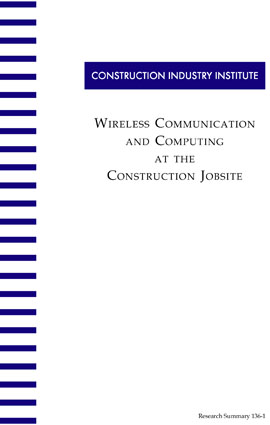
Wireless Communication and Computing at the Construction Jobsite
For many years, the walkie-talkie has been synonymous with the construction industry. During jobsite project execution, there are three variables which can either hinder or facilitate successful results, namely, quality, quantity, and timing of information. Wireless data communications technology is capable of delivering just-in-time information within the “last mile” between the trailer and a desired location on the jobsite.
This study surveyed information needs at the jobsite, emerging wireless data communications technology, and assessed the extent to which wireless data technology can fulfill the information needs of the jobsite. Two examples are included to illustrate how to match a set of information needs with appropriate wireless technology.
The study organized jobsite information needs into the following ten categories: a) Requests for Information; b) Materials Management; c) Equipment Management; d) Cost Management; e) Schedule and Means & Methods; f) Jobsite Record Keeping; g) Submittals; h) Safety; i) QC/QA; and k) Future Trends. Each category was analyzed in terms of its appropriateness to take advantage of wireless technology. The four formats considered to transmit information wirelessly were: a) live voice; b) live video; c) batched data; and d) live data.
A representative inventory of current wireless communication technology was developed and classified into the following five classes: a) Circuit-Switched Wireless Data Systems; b) Packet-Switched Wireless Data Systems—this class was further subdivided into Specialized Mobile Radio Systems and into Cellular Digital Packet Data Systems; c) Wireless Local Area Networks; d) Paging Systems; and e) Satellite-based Data Communications. A Primer for wireless communications covering both fundamental and advanced communications concepts was also developed to enable a better understanding of the issues involved in making trade-offs while configuring a wireless jobsite communication system.
The first example presented in this document shows how a contractor can define a subset of information needs by choosing from those already articulated herein and determine if a given wireless technology should even be considered as a viable way of meeting the information needs that such company has. The second example presents a more generic six-step methodology allowing a company to articulate and analyze their own information needs and to match those with current wireless hardware.
The Construction Industry at-large will profit from leveraging walkie-talkie wireless voice communication with wireless data communication. Wireless technology like Cellular Modems, Wireless LANs, CDPD Modems, Pagers, and Satellites can do it now. For a given construction firm, what is important is to understand that there is a trade-off between the value of information and the cost of obtaining it. While value and cost are time dependent variables, the marginal benefit of obtaining the information wirelessly must exceed the marginal benefit of conventional practice.



